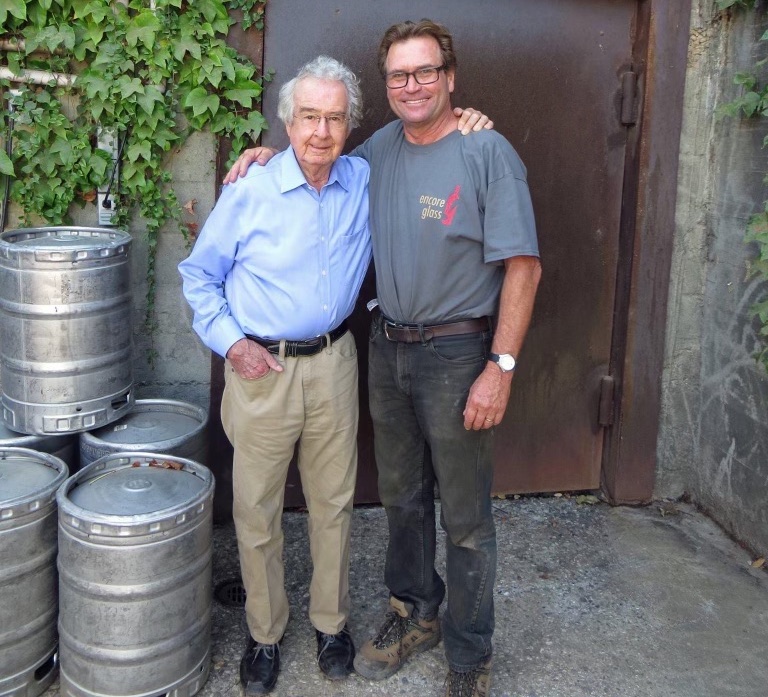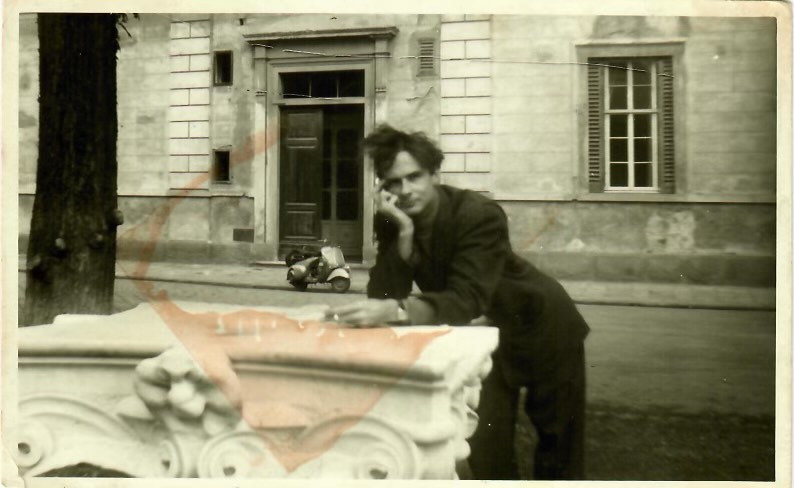
January 13, 2023 – Sometime around the end of the first decade of this century (let that sink in), The Santa Cruz Mountains Winegrowers held a seated tasting of older Cabernet Sauvignons at The Mountain Winery in Saratoga.
I remember carefully opening many dust and grime-covered bottles with corks that were soaked through, splintered and even decayed, decanting them into anything we could find in the prep kitchen. Since several of the winemakers showed up late with their wines (and without corkscrews – go figure), the activity was fevered and intense, and we were also short-handed due to weather delays.
Back then, I carried at least three corkscrews with me, of various types. Either Marty Mathis or Jeff Emery had an Ah-so style, which helped greatly on those cellar treasures.
While pouring for the sold out seminar crowd, I spied a handsomely dressed older gentleman standing by the doorway. He had a twinkle in his eye and a forthcoming demeanor.
I realized after a moment that I was talking to Warren Winiarski of Stag’s Leap Winery fame: as in the guy who literally put Napa on the world stage by winning the Judgment of Paris in 1976 with his 1973 Stag’s Leap Cabernet Sauvignon. It beat out all the French entries, and all the French judges thought it was from Bordeaux. Little did they know it was from a vineyard Winiarski and his wife Barbara had planted in 1970 in the Stag’s Leap District of Napa.

The significance of all this did not really dawn on me until I spoke with Winiarski the other day for a story. I learned that Jeffrey and Ellie Patterson had invited him to pour at that seminar, but I didn’t understand the deeper connection. What I did understand was this man was special in a way that profoundly touched me.
While tasting the Santa Cruz Mountains Cabernets next to some examples from Napa during that somewhat chaotic tasting (we got terribly off schedule because some presenters went wildly over their allotted timeslots), two things immediately stood out. Those older Napa Cabs tasted nothing like the current versions, and the Santa Cruz Mountains ones were as lean and mean and filled with leather and tobacco as an episode of Rawhide. These things had stuffing: and those older Napa ones from Heitz and Stag’s Leap did, too.
Winiarski made a comment about those older Cabs that struck me as utterly brilliant. “The perfect wine,” he said, “Is complete. It has a beginning, a middle and an end. It has nothing extraneous. It leaves you wanting nothing. It is just… enough.”
He echoed that sentiment and explained it a little more deeply when we spoke recently. “That definition of ‘complete’ comes from Aristotle,” said Winiarski, a former lecturer in Liberal Arts who earned a masters degree at the University of Chicago’s Social Sciences Division (with a specialty in Social Thought).
After living in Italy and reveling in the wine and food culture while doing his thesis, Winiarski and his wife Barbara, a painter he had met as an undergrad at St. John’s College in Annapolis, Maryland, decided to pursue a new life in wine.

What most people don’t know is that Winiarski was fascinated by the work of Martin Ray, who by that time had gained some fame for the wines he was producing from Mount Eden in Saratoga. Winiarski wrote to Ray and asked him for an apprenticeship. It didn’t last long, as the two both possessed rather large personalities, but it gave Winiarski a deep appreciation for the wines from that property that he treasures to this day. There was something deep, lean and resonating about those wines.
But Napa was where the action was, so Winiarski went off to take a job under Lee Stewart at Souverain. Then he worked with the legendary Russian vintner André Tchelistcheff, who cemented in his psyche the fundamental importance of beauty in a wine.
When Robert Mondavi started building the first new winery in Napa Valley since Prohibition in 1966, he asked Winiarski to be his assistant winemaker. That lasted about two years until Winiarski decided to strike out on his own.
He kept tasting grapes and unblended wines from many different vineyards in the Napa Valley, looking for that perfect expression of Old World style in a New World setting. He finally tasted a wine that came close to his idea of perfection: it was made by grower Nathan Fay, so he bought an old prune orchard adjacent to Fay’s vineyard. It was from that spot that he crafted the 1973 Stag’s Leap Cabernet that changed the course of wine history. In honor if its significance, a bottle is enshrined at The Smithsonian Institution’s Museum of American History in Washington D.C.

“It was a Copernican moment,” says Winiarski. “That the French judges thought this wine was French showed we could make classically styled wines here in the New World.”
Winiarski, now 94, sold Stag’s Leap in 2007 and hasn’t made wine since. He misses doing so very much, but he still consults with the present team at Stag’s Leap, and also has his own project called Arcadia Cellars in Coombsville. He told me he recently got some Cabernet cuttings from Jeffrey Patterson at Mount Eden Vineyards to install at his Napa site and is extremely excited about the prospects. It appears he is still chasing that elusive expression of the Santa Cruz Mountains that first captured his imagination.
Jeffrey Patterson of Mount Eden told me that Winiarski, upon tasting a bottle of 1990 Mount Eden Cabernet that Patterson had sent him, was so blown away that he got in touch and came to visit.
“He has never forgotten his time at Mount Eden,” says Patterson. “He has a deep, romantic memory of his time working with Martin.” The two became fast friends and found themselves on the same page when it came to winemaking styles.
“He told me over dinner that when he was at Stag’s Leap, he never let a ferment run longer than 8 days. He was after an elegant, non-extracted style. Think about that! Nobody does that in Napa!” Patterson says the cuttings he gave Winiarski came from David Gates at Ridge, and were cleaned up Rixford clone budwood that UC Davis had virus-treated. Ray had originally planted the Rixford clone of Cab at Mount Eden, it is the predominant clonal material on that site today. When Patterson was replanting the old Cinnabar property, which is now Domaine Eden, he wanted the cleaned up version, which he says is virtually indistinguishable from the original clone, except for more consistent cluster morphology.
Winiarski—who still teaches a Summer Classics program in the great works of literature, science, history, philosophy and opera on the Santa Fe campus of St. John’s College—has earned many honors and awards, among them the James Smithson Bicentennial Medal from the Smithsonian Museum of American History in recognition of his contributions to American winemaking and the museum’s American Food & Wine History Project. To date, he is the only winemaker to do so.
What drives him still, besides all his many philanthropic and land conservation projects? The endless pursuit of perfection. “ You have to have a deep love for what you do and what you are creating,” he told me. “If you don’t, it’s a dim light.”
He has constantly spread that light and launched so many winemakers on their way to greatness, including Michael Silacci of Opus One and John Kongsgaard of Kongsgaard Wines, both of whom shared wonderful anecdotes about working with him.
As an intern at Stag’s Leap in 1977, Kongsgaard says that Winiarski would often appear in the cellar at 2am in his bathrobe to discuss a potential variation to instructions he had given earlier. “Nothing was to be taken for granted, and there was a logic behind every move, in the cellar and in the vineyard,” says Kongsgaard. “All of us who had the pleasure of working with Warren remember that wine is to be beautiful and classically proportioned.“
During the interview process for a job at Stag’s Leap in 1995, Michael Silacci remembers a terrifying drive through the Atlas Peak vineyards, with Winiarski revving his BMW 540i “like Mario Andretti.”
Winiarski asked if he wanted a cup of coffee, then reached into his pocket and handed Silacci three coffee beans. This prompted Silacci to share a story of how he survived long nights as an intern in Oregon on chocolate covered espresso beans.
“Ah!” said Winiarski, excitedly. “You place one on your tongue and you feel the chocolate melting: it is sweet and creamy. Then you bite into the bean and taste the bitterness and astringency. You take all these flavors and sensations and separate them. Then you evaluate them intellectually and sensorially. That is what we want our customers to do with our wine.”
Perhaps Winiarksi will succeed in recreating that unforgettable taste of the Santa Cruz Mountains that he remembers from the Mount Eden Cabernet Sauvignons of the 1960s that launched his own wine voyage all those decades ago. We can only hope that it happens soon, and that it is the most beautiful thing he has ever created.
About the author
Laura Ness is a longtime wine journalist, columnist and judge who contributes regularly to Edible Monterey Bay, Spirited, WineOh.Tv, Los Gatos Magazine and Wine Industry Network, and a variety of consumer publications. Her passion is telling stories about the intriguing characters who inhabit the fascinating world of wine and food.
- Laura Nesshttps://www.ediblemontereybay.com/author/lness/
- Laura Nesshttps://www.ediblemontereybay.com/author/lness/
- Laura Nesshttps://www.ediblemontereybay.com/author/lness/
- Laura Nesshttps://www.ediblemontereybay.com/author/lness/


